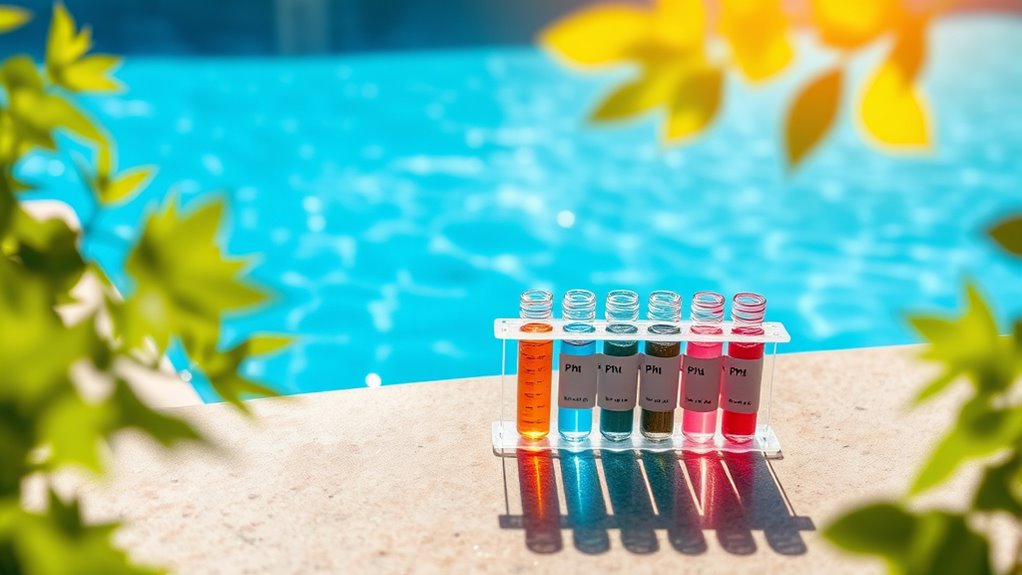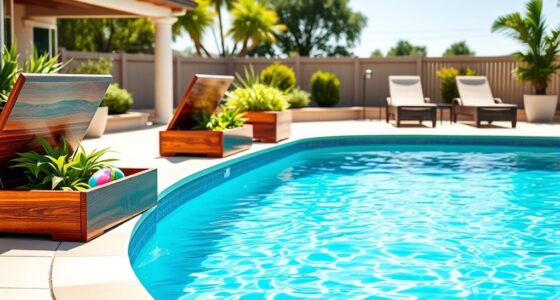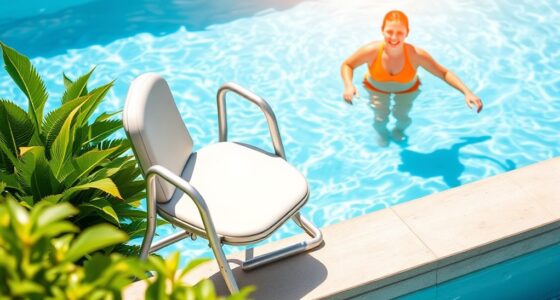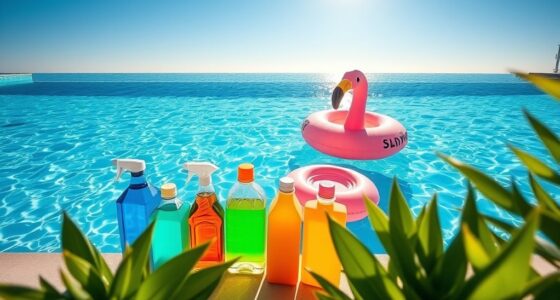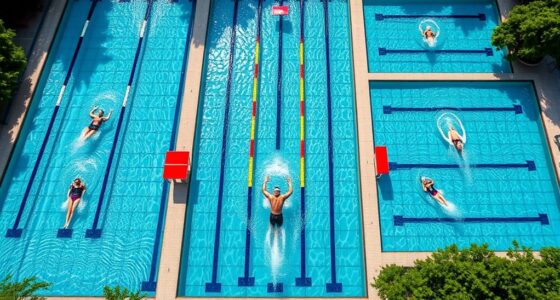Maintaining proper pH balancers in your pool is essential for a safe and enjoyable swim. When pH levels fall between 7.2 and 7.8, it enhances comfort, protects equipment, and keeps water clear. An imbalance can cause skin irritation and cloudy water, affecting your experience. Regular testing and chemical adjustments help you achieve this balance, ensuring effective sanitizer performance. Discover more about how to maintain ideal pH levels and the role of technology in managing your pool.
Key Takeaways
- pH balancers maintain the ideal pH range of 7.2 to 7.8, ensuring a safe and comfortable swimming experience.
- Proper pH levels enhance sanitizer efficiency, preventing water clarity issues and swimmer discomfort.
- Imbalanced pH can cause skin and eye irritation and may lead to cloudy water.
- Regular use of pH adjusting chemicals is essential for maintaining water quality and prolonging pool equipment life.
- Automatic pH control systems simplify management, providing precision over water chemistry for optimal pool health.
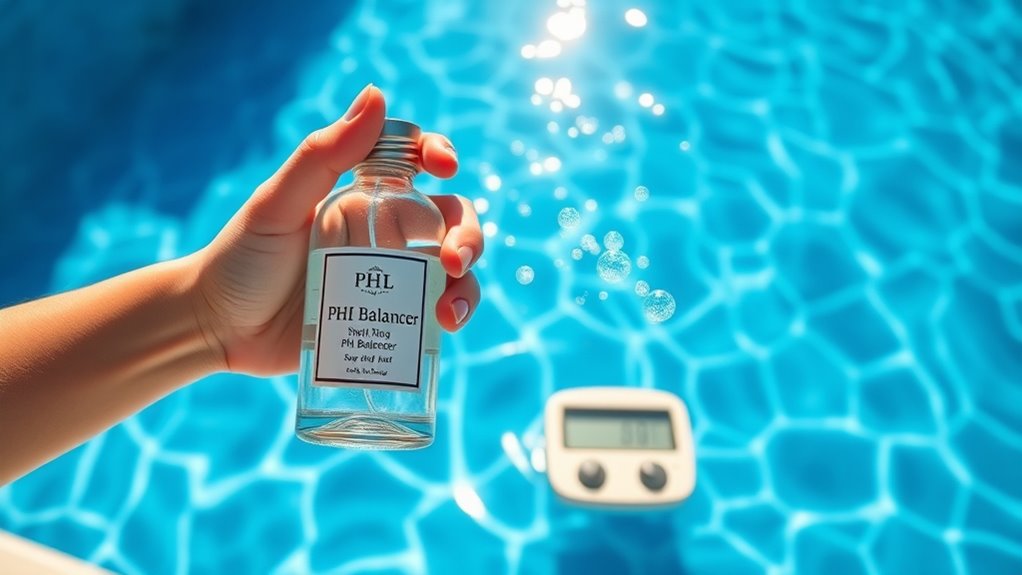
Maintaining the right pH balance in your pool is vital for a safe and enjoyable swimming experience. pH balancers are the key chemicals that help you adjust the acidity or basicity of your pool water, guaranteeing it stays within the ideal range of 7.2 to 7.8. A proper pH balance not only enhances swimmer comfort but also prolongs the life of your pool equipment. When pH levels drift outside this range, it can lead to discomfort and potential damage, making regular monitoring essential.
Maintaining proper pH balance is essential for safe swimming and prolonging your pool’s equipment life. Regular monitoring is key.
You need to understand that the pH scale measures acidity or basicity from 0 to 14, with 7 being neutral. If your pool’s pH is too high, often caused by lost carbon dioxide during use or certain treatment chemicals, it can lead to scaling and reduced sanitizer efficiency. Conversely, a low pH can result from dissolved atmospheric carbon dioxide in stagnant water or specific cleaning substances, leading to corrosion of your pool surfaces and equipment. That’s why managing these fluctuations is vital for both comfort and maintenance.
Proper pH balance guarantees that chlorine and other sanitizers work effectively in killing bacteria, keeping your pool safe for swimmers. When pH is off, not only can skin and eye irritation occur, but you might also notice cloudy water. Regularly testing and adjusting the pH helps maintain clear and inviting water, making your swimming experience more enjoyable.
Fortunately, modern technologies can aid you in this task. Automatic control systems, like those from Fluidra, allow you to maintain ideal pH levels effortlessly. These advanced systems provide precision management over pH, alkalinity, and chlorine levels, guaranteeing your pool is always swim-ready. Some even integrate electrolysis processes for enhanced water quality and sustainability.
To effectively manage pH, you’ll need to use various chemicals. pH increasers raise the level when the water is too acidic, while pH reducers lower it when it’s too alkaline. Alkalinity adjusters, like sodium bicarbonate, are essential for stabilizing pH levels against sudden changes.
Frequently Asked Questions
How Often Should I Test My Pool’s Ph Level?
You should test your pool’s pH level at least once a week during the swimming season.
If your pool experiences heavy usage or harsh weather, increase the frequency.
Use pH test strips or a pool test kit for accurate results.
Remember, new pools require daily testing until stabilized, and you should check the pH more often before and after pool parties or events.
Keeping an eye on pH levels helps maintain a safe swimming environment.
Can I Use Household Items to Adjust Ph Levels?
Did you know that nearly 30% of pool owners try using household items for pH adjustments?
While you might think baking soda or vinegar could work, they often lack the precision needed for effective pH balancing.
Using these items can lead to inconsistent results and even equipment damage.
It’s safer and more reliable to stick with commercial pH balancers designed specifically for pools, ensuring your water stays safe and balanced.
What Are the Signs of Improper Ph Balance?
If you’re dealing with improper pH balance, you might notice a few telltale signs.
Red, irritated eyes and dry skin can be common complaints for swimmers. You could also find scaling on surfaces or cloudy water that doesn’t look inviting.
Additionally, chlorine may not work effectively, allowing bacteria to thrive. If you’ve experienced any of these issues, it’s time to check and adjust your pool’s pH levels for a better swimming experience.
Do Ph Balancers Affect Pool Chemistry in Other Ways?
Did you know that nearly 80% of pool issues stem from improper pH balance?
pH balancers greatly impact pool chemistry beyond just stabilizing acidity. They enhance sanitizer efficiency, ensuring chlorine works effectively, and help maintain total alkalinity, which acts as a buffer.
By optimizing chemical interactions, you’ll reduce the need for additional treatments, saving you time and money.
Ultimately, proper pH management leads to clearer water and a more enjoyable swimming experience.
Are There Different Ph Balancers for Saltwater Pools?
Yes, there are different pH balancers specifically for saltwater pools.
You’ve got muriatic acid, which is effective but can be hazardous to handle.
Then there’s dry acid, or sodium bisulfate, which is safer and easier to use.
Automatic acid dosing systems can also help maintain pH levels conveniently.
Using the right balancer guarantees your pool’s chemistry stays in check, keeping it clean and comfortable for you and your swimmers.
Conclusion
In the grand symphony of pool maintenance, pH balancers play the role of the conductor, ensuring harmony and balance. Without them, your pool’s water can become a discordant mess, inviting algae and irritation instead of invigorating joy. So, don’t overlook these silent guardians; they keep your aquatic oasis sparkling and inviting. By nurturing the right pH levels, you’re not just protecting your investment—you’re crafting a serene escape that dances with the sun and beckons you to plunge in.
